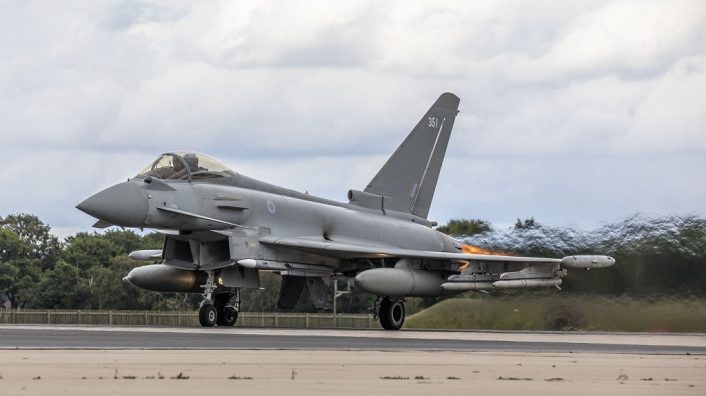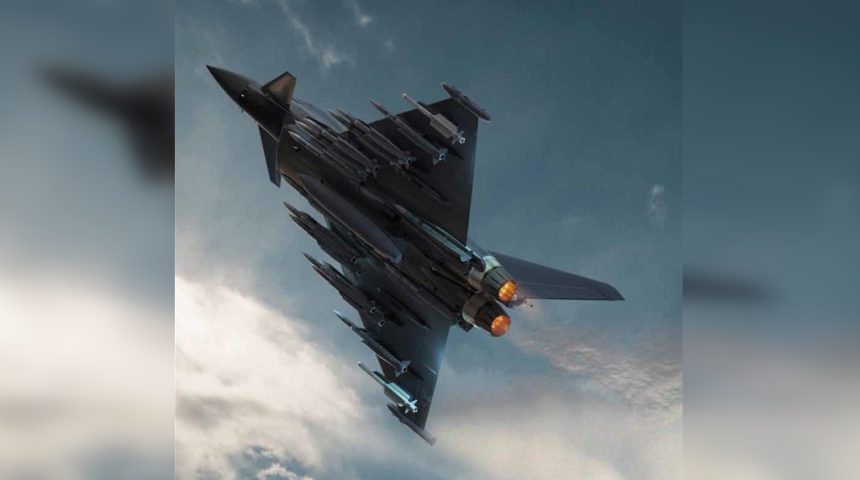The quite unlikely Typhoon’s “Beast Mode” configuration might hint at a possible “missile/bomb truck” role in support of 5th and 6th gen. fighter aircraft.
Last week the Eurofighter website published the latest edition of its magazine Eurofighter World. An interesting image can be found in the last page, showing a Typhoon rendering in an astonishing “Beast Mode” with 14 Meteor Beyond Visual Range (BVR) and two IRIS-T (InfraRed Imaging System Tail-Thrust Vector Controlled) short-range air-to-air missiles, along with an external fuel tank on the centerline station.
This quite improbable configuration was obtained by using twin missile rails on the two inner pylons, a solution that was never showcased for the Typhoon. So far, the only multi-rail launcher seen on the real aircraft is the one used to carry three Brimstone air-to-surface missiles, while computer generated images and mockups showed also twin racks for Paveway and JDAM guided bombs and another one capable of carrying four SPEAR 3 air-to-surface missiles.
Such configuration might be at the limit of what is currently possible, if it is possible at all.
Packed with interviews with pilots, experts and professional photographers, this edition of the #EurofighterWorld magazine is a must-read for all fighter jet fans. Download here: https://t.co/VnrjO6Uusr #EF #EFW #magazine #Eurofighter #Typhoon #weareNATO #aerospace #Quadriga pic.twitter.com/c6nu8SB667
— Eurofighter Typhoon (@eurofighter) February 5, 2021
Weight-wise, using publicly available data, the full load including 1,000 liters fuel tank, 14 Meteor (190 kg each) and two IRIS-T (89 kg each) missiles is just below 4,000 kg, less than half of the Typhoon payload which is rated at more than 9,000 kg [even though some sources state the external payload is 6,500 kg].
The Typhoon is no stranger to heavy configurations, even flying its display during RIAT 2011 with a full load of missiles, bombs and external fuel tanks. However, many factors other than weight could limit this 14 Meteor configuration.
Before moving on, here’s a quick description of the Meteor BVRAAM.
The missile was developed by a group of European partners led by MBDA to meet the needs of the UK, Germany, Italy, France, Spain and Sweden. Considered one of the most lethal BVR missiles available today, Meteor is powered by a ramjet propulsion system, a solid fuel, variable flow, ducted rocket.
The advantage over a standard rocket motor, like the one used by the AIM-120 AMRAAM, is that the ramjet is throttleable, meaning that the missile can throttle back its engine during cruise and then throttle up at close distance from the target to obtain the highest possible energy state during the terminal attack.
This way, Meteor can provide a larger No-Escape Zone without losing precious energy while countering the target’s defensive manoeuvres. A datalink provides mid-course updates about the target sent by the launcher aircraft to increase the Probability of Kill (Pk). The missile is equipped with both impact and proximity fuses and a fragmentation warhead to maximise the lethality. Meteor has currently been integrated on the Typhoon, Gripen and Rafale and is scheduled to be integrated on the F-35.
Today we are used to see the F-35 Lighting II in the air-to-ground “Beast mode” when weapons are carried externally. However, a similar air-to-air configuration never materialized, even if it was announced by Lockheed Martin. In the F-35’s case, the aircraft would carry 14 AIM-120 AMRAAM (even if renderings showed only 12) and two AIM-9 Sidewinder missiles, with the AMRAAMs on the outside using twin missile racks. It is worth noting that the AIM-120 has not been certified yet to be carried externally by the F-35.
Another air-to-air “Beast mode” is the one advertised for the new F-15EX, which would carry up to 22 missiles by using newly designed launcher-racks called Advanced Missile and Bomb Ejection Rack (AMBER), patented by Boeing in 2016, which would allow to carry two missiles under each attachment point (on both the wings and FAST packs). Photos online shows at least a static ground test on a FAST pack-equipped F-15C with two AMBER racks and an unspecified rack under the wing pylon.
The F-15, however, is the only fighter to have flown in the air-to-air “Beast mode”. In 2018 Boeing flew an F-15SA test aircraft, with only standard missile rails, while carrying 12 AIM-120 missiles and two external fuel tanks, which also resulted in some great photos when the aircraft was taken for a ride through the Star Wars canyon.

Back to the Typhoon, even if a configuration like the one seen on Eurofighter World becomes real, it does not mean that we will see it flying operationally. For instance, two of the twin missile rails might end up being replaced by two external fuel tanks, as the Typhoon nowadays is rarely seen with a tank only or with no tanks at all. Even with this adjustment to the loadout, the Typhoon would still pack more missiles than the heaviest air-to-air configurations adopted until now, which see a total of eight missiles (either four Meteors/AMRAAMs and four ASRAAMs/IRIS-Ts or six Meteors/AMRAAMs and four ASRAAMs/IRIS-Ts) and two external fuel tanks.
Should the Typhoon get a new role as a “missile/bomb truck” in support of the F-35 now and of the FCAS/SCAF or the Tempest FCAS-TI in future, similarly to what the F-15EX is supposed to do with the F-35 within the U.S. Air Force, the heavy configuration with up to 14 Meteors would make sense. 5th and 6th generation aircraft, due to their low observability, are forced to carry their weapons only internally and this restricts both the quantity and the dimensions of the weapons.
The Typhoon could follow the stealth aircraft from a safe distance while carrying a lot of standoff weapons; the stealth aircraft could then even send targeting data back to the Typhoon via datalink and provide target designation to launch the weapons.
However, we should also consider the concrete possibility that such a configuration will never materialize, as happened for other upgraded that were announced for the Typhoon. Two examples are the Conformal Fuel Tanks (CFT) and the Aerodynamic Modification Kit (AMK).
The addition of two 1,500 liters CFTs to the Typhoon was proposed in the early 2010s and showcased on some mockups during several exhibitions and airshows around the world. Testing on a wind tunnel Typhoon model equipped with the CFTs was performed by BAE Systems in 2014, as it was planned to offer the new tanks for the Tranche 3 aircraft, which were being built with the required structural and fuel system modifications to carry the CFTs.
The new CFTs, however, proved to be a no-go as testing showed that they are “aerodynamically unstable” for the Typhoon. It is worth noting that the Typhoon itself has been designed to be aerodynamically unstable in subsonic flight, providing enhanced manoeuvrability, and aerodynamically stable in supersonic flight. Another reason is that the Typhoon operators did not show much interest in the CFTs as they were not deemed cost effective, however an internal fuel increase and larger external fuel tanks may be in the works under the Long Term Evolution (LTE) programme.
Don’t expect conformal fuel tanks to be coming to a Eurofighter near you any time soon. In answer to question as to why CFTs don’t feature on ECR version, official noted no real customer appetite. “There are more cost effective ways to increase range of a Eurofighter.” pic.twitter.com/g5dFT1uGsi
— Gareth Jennings (@GarethJennings3) November 12, 2019
The AMK was part of a wider Eurofighter Enhanced Manoeuvrability (EFEM) programme and featured the addition of fuselage strakes and leading-edge root extensions, which increase the maximum lift created by the wing by 25% resulting in an increased turn rate, tighter turning radius and improved nose-pointing. However, none of the Typhoon operators seem to have yet installed the AMK on their aircraft after the successful flight tests in 2015.
“We saw angle-of-attack values around 45% greater than on the standard aircraft, and roll rates up to 100% higher, all leading to increased agility,” said the then Italian Air Force test pilot Raffaele Beltrame, one of the pilots who flew during the 36 test flights on the IPA7 (Instrumented Production Aircraft 7) in Germany. “The handling qualities appeared to be markedly improved, providing more manoeuvrability, agility and precision while performing tasks representative of in-service operations.”









